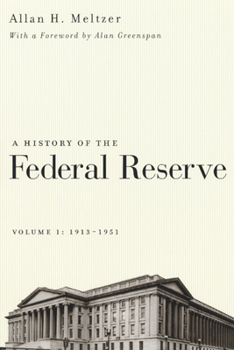A History of the Federal Reserve, Volume 1: 1913-1951
(Part of the A History of the Federal Reserve Series)
Select Format
Select Condition 
Book Overview
Allan H. Meltzer's monumental history of the Federal Reserve System tells the story of one of America's most influential but least understood public institutions. This first volume covers the period from the Federal Reserve's founding in 1913 through the Treasury-Federal Reserve Accord of 1951, which marked the beginning of a larger and greatly changed institution. To understand why the Federal Reserve acted as it did at key points in its history,...
Format:Paperback
Language:English
ISBN:0226520005
ISBN13:9780226520001
Release Date:June 2004
Publisher:University of Chicago Press
Length:808 Pages
Weight:2.40 lbs.
Dimensions:1.7" x 6.1" x 8.9"
Customer Reviews
3 ratings
Comprehensive, but could have used an editor
Published by Thriftbooks.com User , 14 years ago
In modern scholarly publishing, the author is largely on his own. If the book is to read smoothly and be free of errors, it's pretty much up to the author -- or the author's friends and colleagues -- to do the careful proofreading required, especially in a book of this length. Perhaps not too surprisingly, Meltzer having finished the prodigious labor of writing this volume -- and with two more lengthy volumes still to write! -- did not, in fact, do much proofreading. As a result, this book is what in an earlier day would have been seen as a first draft. A monumental, incredibly well researched first draft, but a first draft nonetheless. As a result there a significant number of typos or small errors. To take one of many, the large New York City bank that failed in October 1930 was the Bank of United States, not the Bank of the United States, as Meltzer has it. The reasons why the bank's founders dropped the "the" in the bank's name is actually a significant story, albeit one that Meltzer omits. Apart from these minor blemishes, the apparent failure to significantly revise the manuscript results in problems with the narrative flow. It's not just that the level of detail is a bit excessive or the discussion often drifts from the main point -- a failing noted by one of the other reviewers -- but people and incidents are discussed on one page, dropped, and then picked up again dozens of pages later with the reader expected to have perfect recall of the earlier mention. This problem is made worse by the fact that the index is rather sketchy. So, trying to find the earlier reference to a person or incident is difficult. These are things a good editor would have caught, if Meltzer had had one. Leaving these points aside -- and they aren't trivial because they significantly reduce the readability of the book -- Meltzer's history is as definitive as we are ever likely to get. Anyone who writes about the early history of the Fed will have to take Meltzer into account.
Impressive book!
Published by Thriftbooks.com User , 15 years ago
This is a great back story for the Federal Reserve and the financial systems that are in use today. It is well researched; it is not for the faint of heart. At least I sleep a little better for having read it. I am looking forward to how the Federal Reserve will address the problem of offering an interest rate below 0%. (The Fed is kind of caught between a rock and a hard place on this one.) I have enormous confidence that the author will do a great job on the next two volumes in this trilogy (Book 2 Volume 1 and Book 2 Volume 2.) C. Ziemba CMU EE '70 & '72 I would really like to see Book 3 (1987-2009) from this author. It would be worth its price.
Not for the layman
Published by Thriftbooks.com User , 21 years ago
This much heralded account of the Federal Reserve is justly lauded in academic circles because Meltzer brings forth many Fed documents which have long been buried away and unavailable to scholars. He is able to pursue step-by-step Fed actions and relate what happened in all those many meetings behind closed doors. Through the mass of information he has uncovered and his own in-depth knowledge of monetary policy and the Fed, he is able to bring new facts to light and correct previous interpretations that are more often than not those of Friedman and Schwartz's A Monetary History of the United States.The weaknesses of Meltzer's book stem from his massive archive of information and the strength of his predecessors. The sheer volume of information he is trying to convey prompts the narrative to drift and the reader sometimes loses the point. And, as a good academic historian, he is engaged in a dialogue with other historians of the Fed and monetary policy that can push the layman to the sidelines. Meltzer's history assumes the reader has a rather advanced knowledge of economics and finance such as an understanding of the real bills doctrine and the operation of an international gold standard. Also, the charts and tables are often not very helpful in understanding the text or at least could have been presented in a better manner. Overall, Meltzer does not produce any stunning revelations but a great many correctives to previous accounts and much added detail. The novice to the history of US monetary policy would do better to read Richard Timberlake's book (though taken with a grain of salt because of its conservative leanings) or the classic work by Milton Friedman and Anna Schwartz.






